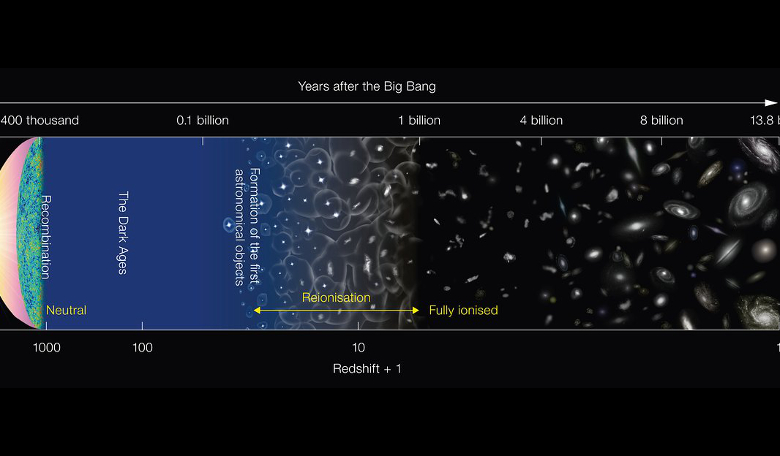Astronomers looking for true galactic fossils of the Reionisation era – a period of time after the Big Bang when light from the first massive stars split hydrogen atoms back into electrons and protons – have found a dwarf galaxy that could help researchers understand more about this mysterious period in the Universe’s history.
Until around a few hundred million years or so after the Big Bang, the Universe was a very dark place, devoid of stars and galaxies. Then the Universe started to cool and as it did, the hot soup of particles such as protons, neutrons and electrons that filled up the darkness, began to combine to create the very first atoms (predominantly hydrogen atoms). This process of particles pairing up is called "Recombination" and it occurred approximately 240,000 to 300,000 years after the Big Bang.
This is not to be confused with the epoch of Reionisation. This era, from the end of the dark ages to when the Universe was around a billion years old, relates to a period when the first massive stars – stars that were 30 to 300 times as massive as our Sun and millions of times as bright – burned for only a few million years before collapsing as supernovae. When the stars exploded, the energetic ultraviolet light emitted from the stars was capable of splitting hydrogen atoms back into electrons and protons (or ionising them); hence an era of reionisation begins.
This epoch is an important era in our Universe's history as it presents an opportunity in which to (indirectly) study these earliest stars, as it is not known exactly when they first formed and when this reionisation process started to occur.
One way to help understand what might have gone on in this era is the study of dwarf galaxies. Dwarf galaxies are labelled as such because they are only about one tenth the size of our galaxy (and most of them are smaller). Nonetheless, these diminutive galactic cousins are the most common type of galaxy in the Universe and it is surmised that regular mergers of these small systems led to the formation of bigger galaxies such as the Milky Way for instance.
Researchers are therefore keen to find examples of the very earliest dwarf galaxies in order to help refine theories of galaxy formation and evolution. And now, a team of astronomers from Spain and Italy, have found what appears to be a true fossil of the Reionisation era.
After studying the star formation history of a galaxy known as the Sextans dwarf spheroidal galaxy, the team, whose lead author on the research paper is M. Bettinelli from the Instituto de Astrofısica de Canarias, Tenerife, found that Sextans stopped forming stars less than approximately 1.3 billion years after the Big Bang – the end of the reionisation epoch.
The team were also able to constrain that the main burst of star formation lasted for around 0.6 Gyr (billion year). Whether or not Sextans stopped star formation early due to processes linked to the ultraviolet (UV) cosmic reionisation, or if it is mainly due to local causes, such as supernova feedback or intense galactic winds, is not yet clear.
However, the team do state that their analysis leans more towards the idea that penetrating light from supernovae completely blew out the gas from the galaxy, thus preventing the formation of any new stars.
Either way, the discovery that star formation activity within Sextans corresponds to this crucial turning point in the Universe's evolution will be a huge boost to researchers. Understanding these first sources is critical, as they reveal information about the end of the cosmic dark ages, the first stars and galaxies, and the structure of our Universe as we see it today.
More on this research can be found at https://arxiv.org/pdf/1801.08145.pdf











